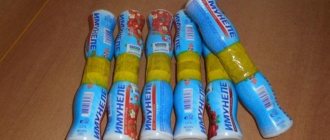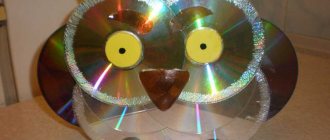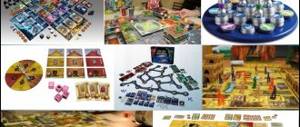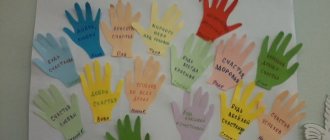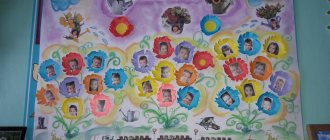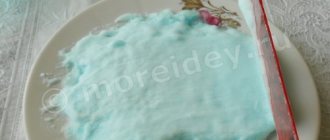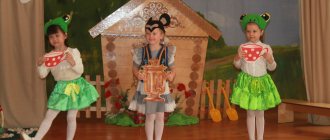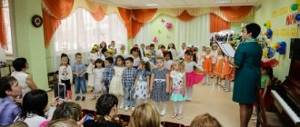Sources:
1. https://www. mbdou-teremok. ru/fizkultura/2016-03-24/nestandartnoe-fizkulturnoe-oborudovanie-svoimi-rukami.
2. https://www. maam. ru/detskijsad/prezentacija-ispolzovanie-nestandartnogo-oborudovanija-po-fizicheskomu-vospitaniyu-v-rabote-s-detmi. html.
Municipal budgetary preschool educational institution, general developmental kindergarten No. 11 “Firefly” of the municipal formation Timashevsky district
Guidelines for
kindergarten teachers
Developed by: teacher MBDOU d/s No. 11
"BILBOKE"
Material: the top of plastic bottles, a Kinder Surprise container or ball, colored thread or ribbon.
Goal: Improving the ability to throw an object up or catch it; develop the eye, reaction speed, coordination of movements of the forearm and fingers, dexterity, accuracy, eye, arbitrariness of behavior, reaction speed. Cultivating perseverance, perseverance, a positive spirit of competition, developing self-control skills.
Use case: Children throw the container up and catch it with a bottle. If you caught it, well done! Games “Who is the most dexterous?”, “Hit the target”, games of a competitive nature.
The purpose of these guidelines is to increase children's interest in physical education, create a need for independent action, and also attract the attention of parents to the problem of maintaining children's health.
It's no secret that the health of the child comes first for every parent. The most effective and affordable means of increasing health potential is physical education and, above all, physical activity. In practice, we are convinced of a decrease in children’s interest in physical activity, their inactivity, and reluctance to take part in outdoor games. Which leads to an increase in morbidity.
How can we make the world of movements truly attractive and interesting for children and parents? To solve this problem, in our group “Semitsvetik”, we use non-standard equipment made by parents, children and teachers with their own hands, which allows you to quickly and efficiently develop motor skills and abilities and helps to increase interest in physical education activities, making children’s movements more diverse, develop creativity and imagination.
Classes with non-standard equipment can be both entertaining and training in nature; they can be organized in the form of game, plot, thematic, educational and training sessions. The novelty lies in the unusual shape and colorfulness of non-standard equipment, which attract the attention of children and increase their interest in performing basic movements and exercises and contribute to a high emotional tone during classes.
The manufactured non-standard equipment is small-sized and quite versatile, and is easy to process. It is easily transformed with minimal time and can be used both indoors and outdoors.
Non-standard equipment is an additional incentive to intensify physical education and health activities. Therefore, it is never superfluous and boring. For teachers and parents, I offer several examples of non-standard physical education equipment that you can easily make with your own hands.
How to make sports equipment for kindergarten - interesting attributes
See also how you can make various sports equipment from improvised materials. These are called belboks. To make such sports equipment for children, take:
- laces or ropes;
- plastic bottles;
- plastic boxes from Kinder surprises;
- soft fabric;
- electrical tape;
- threads;
- markers.
Making master class:
- First, cut the plastic bottles. Now draw different flowers here with markers. To prevent children from getting hurt, cover the cut areas with fluffy cloth. You can use an old terry towel as it.
- Use a hot nail to make a hole in the middle of each lid, insert a cord here, and tie the end of it in a knot so that the laces are fixed.
- Attach them to the chocolate egg containers in the same way. Make a hole in this plastic with a hot nail, thread the lace and tie it with a knot on the back side. You can play with these devices in different ways, for example, throw the container up and catch it with the corresponding bottle.
Here is another DIY sports equipment for children.
These palm massagers are made from:
- plastic containers from Kinder surprises;
- Easter thermal stickers;
- pencils;
- thread
Take plastic chocolate egg containers and use a hot nail to make a hole in one side of each. The nail should be quite large so that you can then insert a pencil into these recesses.
To secure these wooden writing sticks, it is advisable to insert them immediately while the plastic is still hot. But if you didn’t have time to do this, then secure the blanks with hot glue.
Make small holes on the other side of the chocolate containers. You will thread threads here, from which you will create tassels. Secure them also with a hot gun.
If you want to decorate these containers, first heat them in hot water, then place iron-on stickers for regular eggs on top. Then you will make the holes.
Such homemade simulators will help children develop fine motor skills and tactile sensations.
It's interesting to twist the pencils between your palms and watch how the brushes develop in different directions.
If the kids are older and don't need plastic blocks, then show them how to transform these old toys. Let them and you draw figures of children doing various exercises. Such drawings should be on each side of the cubes.
Measure the sides that make up these toys, and use these measurements to cut out blanks from paper or cardboard. Now you will need to draw what you have planned, then glue each plate to a specific face of the cube.
To make these toys more durable, you can then additionally cover them with cellophane.
It is very interesting to play sports with such attributes at hand. You can have a competition and roll the dice lightly. Which side will be at the top, such exercises must be performed at the moment.
- Take a cube and write numbers on it. Which number will be at the top, this exercise must be repeated so many times. Therefore, it is advisable to start writing numbers from 10 and above.
- Here is another interesting sports craft made from scrap materials. First you need to fix the wooden pole on the plywood circle. If you do not have such a blank, then use an old wooden mop and attach an additional cross to it at the bottom. Paint these blanks, then the bottom can be decorated with fabric or a rug knitted from threads.
- Take large plastic bottles and cut off their tops. Then you will need to tie these cuts so as not to get hurt and get this beauty. After all, braids for funny characters are also created from these threads. And to tie the edges, you need to take a large needle, thread a thread of yarn into it and overcast the edges so that the turns are located closer to each other.
- All that remains is to use felt-tip pens to draw their facial features and attach them to wooden stands. You can make two holes in each bottle, thread a wire through it and attach these elements, or do it with tape.
If you have old tennis rackets that have broken strings, don't throw them away. See what you can make from such unnecessary attributes.
"FUNNY PENCILS"
Material: the equipment is made of colored pencils or felt-tip pens, the Kinder container is a surprise.
Purpose: to promote the prevention of flat feet, foot massage. Improves blood circulation in fingers, hands and forearms.
Options for use: Palm massage (rotating the barrel of a pencil between the palms), massage of the fingertips, massage of the back and inside of the palm. Foot massage, lifting a pencil with your toes. Use as attributes.
Equipment for sports corner
As already mentioned, educators are often faced with the problem of lack of sufficient funding to organize a sports corner. In this case, most of the accessories are made by hand. We will tell you what inventory options you can create yourself with minimal investment:
- Throwing bags. These bags are pads stitched on all sides with different fillings inside, as shown in the photo. You can use any fabric, the main thing is that it is not too loose to avoid spillage of the filler. You can pour sand, salt, peas, millet, buckwheat inside. Several versions of such bags or one can be made. It will also be ideal if the fabric is decorated with thematic pictures.
- For relay games, flags are required. They are made from small-diameter PVC plumbing pipes and pieces of fabric of the required size. Using the same principle, gymnastic ribbons can be made, which can be decorated more brightly.
- Braids. Such equipment will be needed for teaching kids to jump on two legs at once and for active games. They are made from satin ribbons or rope by weaving.
- Breathing trainer. Created for breathing exercises with the aim of involving children in classes. To do this, you need to tie several threads to the ceiling or a high holder, attach clothespins to them, onto which pictures of animals or other images are put.
- A simulator for developing accuracy. To complete it, you will only need a small container, it could even be half an ordinary plastic bottle and a lot of corks that will act as throwing objects.
- Also a good trainer for dexterity and accuracy would be the ring throw, which can be performed in the form of any fairy tale or cartoon character. Ready-made plastic ones or those made independently from thick cardboard are suitable as rings.
"MASSAGE GLOVES"
Material: Gloves, beads, buttons, threads and needles.
Goal: Increasing the overall tone of the body (help to have a positive effect on the growth and development of the child’s body, relieve fatigue, improve blood circulation, calm the nervous system of preschoolers). Strengthening the immune system and improving the emotional state of the child.
Use: Children massage all parts of the body for themselves and each other.
"BAGS"
Material: Thick fabric or leatherette, sand or salt 150 and 200 grams.
Goal: Development of throwing skills from different distances and from different positions, development of arm strength. Fostering a positive competitive spirit.
Use: For outdoor switchgear classes and outdoor games. The game “Who will throw further?”, “Who will collect it faster?”, “Funny catch-up”. Children stand in a circle and pass 2 bags to each other. Purpose of the game: the bags should not meet, catch up with each other. In competitions, as a relay baton.
Types of sports equipment
Most often, balls of different sizes and configurations, wall bars, basketball hoops, hoops, jump ropes, gymnastic mats, and other types of sports items are used to equip the area for physical education activities with children.
Don’t forget about music, so that children have fun studying. For this, both a regular tape recorder and a special music system are suitable. In addition to the above, the sports corner in kindergarten is always equipped with equipment that is created independently by the work of teachers or parents:
- The so-called health tracks, which are made of fabric with small objects sewn onto it, for example, buttons. Such variants of exercise machines are necessary as a means of preventing flat feet or are used as a regular massager.
- Elements for performing breathing exercises. An example would be light paper figures that the children themselves can make in an appropriate lesson. To develop breathing, such figures are blown away by students from a chair or table in the form of a competition.
- Games with the image of feet and hands, such as “Twister”, which will help develop spatial perception in children and their coordination of movement.
- Expanders.
- Different types of masks and pictures that will help diversify outdoor games.
This list is limited only by the imagination of teachers and parents, so it is necessary to constantly improve the children's sports corner and create new interesting options for accessories for it.
"AIR FOOTBALL"
Material: Box covered with self-adhesive film, goal cups, foil for the ball and straws.
Goal: Develop breathing, exhalation power. Cultivating perseverance, perseverance, and a positive spirit of competition.
Use: in gaming activities.
Progress of the game:
The game is installed on the table. There are 1 player on both sides, armed with straws. The balls are placed in the center of the playing field. The players' task is to score the most goals against the opponent's goal. At the same time, they should not touch the ball with their hands, but can only blow on it through the tubes.
If a player touches the ball with his hand or straw, the opponent receives one extra point. By agreement, the players can introduce some football rules.
Challenges and mistakes when designing a sports corner
When creating a sports corner, educators primarily pursue the goal of creating a healthy environment for children through physical activity. If the placement of equipment is carried out incorrectly, then only some children in the group will be able to engage in physical education, which leads to an irrational use of time.
It is imperative that the teacher convey information to children about the features of outdoor games and their rules in the form of pictures, so that the pupils, especially if they belong to the younger group, are involved in the game and can understand what they are doing.
Educators are also faced with the task of developing children’s dexterity, speed of reaction and good coordination. At the same time, it is imperative to pay attention to the difficulties of each child and help him in overcoming them. It is best to engage in physical education in a playful way with various competitions.
Sometimes you can notice that some children do not exercise in the sports corner, but try to avoid it. There are several reasons for this:
- Uniformity of used simulators and equipment. In this case, the sports corner will be of interest to children only for a few days.
- Inconsistency of equipment for the age group of children. That is why this or that exercise machine or equipment may not be suitable for many.
- The presence of prohibitions from teachers on visiting the corner at a certain time. This is a purely psychological impact that can disrupt the independence and craving for physical education in children.
Very often, the problem in decorating a sports corner in the garden is the small amount of money to purchase the necessary equipment. In this case, it is advisable to make most items with your own hands from scrap materials. Both children and their parents can be involved in this process.
When creating a sports corner, special attention is paid to its lighting, since only in a properly lit space will children be able to receive high-quality physical development and want to play to a greater extent.
